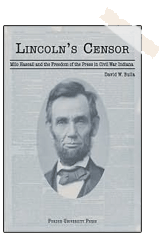

To order:
Click on www.thepress.purdue.edu or call 800-247-6553
Lincoln’s Censor (Purdue University Press, 2009)
David Bulla’s first book, Lincoln’s Censor, was published in August 2008 by Purdue University Press. This book documents an extremely intense period of official press suppression during the U.S. Civil War, a time when the war of words on editorial pages was almost as strong as the war on the battlefields. The book charts how Brigadier General Milo Smith Hascall of the Union Army attempted to intimidate and silence Democratic newspapers in his home state of Indiana at a critical stage in the political life of the war. What makes this book unique is that it looks at press suppression from the point of view, not of a journalist, but from the point of view of military officer—one who just happened to be the brother of a Democratic editor in northern Indiana. This study looks at how and why Hascall suppressed the press and places this six-week campaign into a personal, journalistic, political, military, and legal context. In particular, in looks at how Hascall’s harassment of the press fit into a larger campaign that gained its legs in the summer of 1862 when Dubuque, Iowa, Democratic editor Dennis A. Malony was arrested and shipped to Washington, D.C., to rot while he ran for Congress in absentia. It looks at the major gains that Democrats made in the North in the fall election of 1862 and the emergence of grassroots peace efforts in large part due to the enactment of the Emancipation Proclamation and continued bleak war news, including the disastrous loss at Fredericksburg, Virginia, on December 13, 1862. Lincoln’s Censor relied heavily on a thorough reading of primary documents, especially newspapers on microfilm and letters.
The Peace Press (manuscript submitted to press)
This book documents the chilling effect on freedom of the press in the United States during the Civil War and builds on ideas explored in Lincoln’s Censor. The book charts the rise of the Democratic opposition to the war, primarily in the second half of 1862 and first half of 1863, when Democrats regained some of the political power they had squandered in the election of 1860, and the effort to shackle that opposition. It also explores a small sample of dissenting editors in the South. This study examines the personalities and issues within the context of the development of freedom of the press in U.S. history and the rise and fall of the party press, deliberating on the nature of the political press of the nineteenth century. It looks at how the Peace Democrats argued against the war and how the Lincoln administration and the military countered them with heavy-handed policy and actions that constrained press freedom at a critical moment in the nation’s history. The study shows the depth of Democratic resistance to the war and the prevalence of constraints against the opposition editors. Every region of the Union had Democratic newspapers that came to oppose the war with the Confederacy, and generals, soldiers, and Republican operatives worked to squelch these so-called “disloyal” journals. The anti-war movement was grassroots in nature in large part because the Democratic Party had disintegrated in 1860. The Peace Democrats were attempting to redefine what the party stood for, offering an alternative to the War Democrats. Even though it was a grassroots movement, a piecemeal leadership did emerge, and newspaper editors played major roles. These personalities are looked at in depth. This book, then, assesses how well the press performed in terms of defending its freedom during wartime and in energizing the advocates of an anti-war policy. This study will also show the limitations of the political press and will place the state of press freedom at that time within the context of its development. This author read dozens of newspapers from the period in his construction of the study.Journalism in the Civil War Era (Peter Lang, due out in 2010)
Co-authored with Gregory Borchard, this book looks at how the Civil War affected journalism and how journalism affected the Civil War. It includes a look at a typical newspaper in the 1850s and 1860s; examines how newspapers North and South covered three key battles; and chronicles how the Republican press covered the election of 1860. It also discusses the suppression and intimidation of newspapers both in the North and South.

